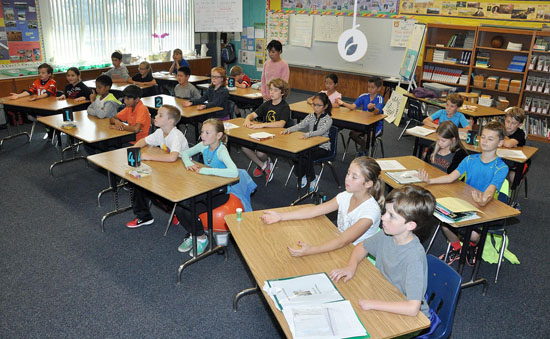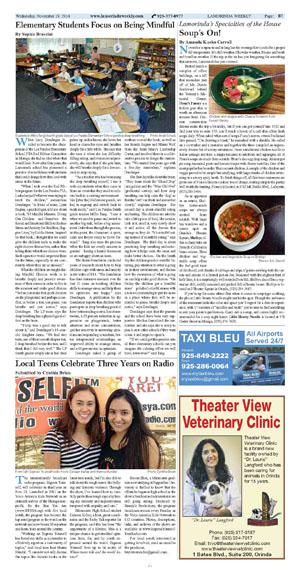|
|
Published November 19th, 2014
|
Elementary Students Focus on Being Mindful
|
|
| By Sophie Braccini |
 |
| Students in Millie Tang's fourth grade class at Los Perales Elementary School practice deep breathing. Photo Andy Scheck |
When Lucy Dendinger decided to become the chairperson of the Los Perales Elementary School PTA Red Ribbon Committee in Moraga, she had no idea where that would lead. Now after four years, the Lamorinda school has pioneered a practice of mindfulness with students that could change how they deal with stress in the future.
 "When I took over the Red Ribbon program for the Los Perales PTA, I asked myself what we were trying to teach the children," remembers Dendinger. "A friend of mine, Lynn Esquer, a psychologist, told me about a book, '10 Mindful Minutes: Giving Our Children - and Ourselves - the Social and Emotional Skills to Reduce Stress and Anxiety for Healthier, Happier Lives,' by Goldie Hawn. Inspired by that book, I thought that we could give the children tools to make the right choices themselves, rather than telling them what these choices were. Such a practice would empower them for the future, especially in our community where they are so stressed."
"When I took over the Red Ribbon program for the Los Perales PTA, I asked myself what we were trying to teach the children," remembers Dendinger. "A friend of mine, Lynn Esquer, a psychologist, told me about a book, '10 Mindful Minutes: Giving Our Children - and Ourselves - the Social and Emotional Skills to Reduce Stress and Anxiety for Healthier, Happier Lives,' by Goldie Hawn. Inspired by that book, I thought that we could give the children tools to make the right choices themselves, rather than telling them what these choices were. Such a practice would empower them for the future, especially in our community where they are so stressed."
 What the children are taught during Mindful Choices week is to breathe deeply and practice awareness of their senses in order to live in the moment and make good choices "Before you make that quick decision on the playground and perhaps a conflict, or before a test, you pause, you breathe and you notice," says Dendinger. The LP mom says the deep breathing has a physiological effect on the brain.
What the children are taught during Mindful Choices week is to breathe deeply and practice awareness of their senses in order to live in the moment and make good choices "Before you make that quick decision on the playground and perhaps a conflict, or before a test, you pause, you breathe and you notice," says Dendinger. The LP mom says the deep breathing has a physiological effect on the brain.
 "Today was a good day to talk about it," said Dendinger's 10-year-old daughter Anna. "We had two tests, one of them a math chapter test. I deep breathed before the test, and I think that I did very well." The LP fourth grader simply sits in her chair palms up on her knees; she bows her head or closes her eyes and breathes deeply for a little while. She says that she uses it when she has difficulty falling asleep, and even more impressively, she says that if she gets hurt, she will breathe deeply for a few seconds to stop crying.
"Today was a good day to talk about it," said Dendinger's 10-year-old daughter Anna. "We had two tests, one of them a math chapter test. I deep breathed before the test, and I think that I did very well." The LP fourth grader simply sits in her chair palms up on her knees; she bows her head or closes her eyes and breathes deeply for a little while. She says that she uses it when she has difficulty falling asleep, and even more impressively, she says that if she gets hurt, she will breathe deeply for a few seconds to stop crying.
 "As a teacher who has been using the deep breathing myself, I use it with my students when they come in from an event that they need to refocus back to a calming environment - like [after the] Halloween parade, we had to regroup and switch back to work mode," said Los Perales fourth grade teacher Millie Tang. "I use it when we need to pause and switch to another big task, before a big assessment I take them through the process, at this point, the classroom is quiet, calm and they're ready to move forward." Tang also uses the process when the kids are overly anxious in general - having a heated discussion or are unhappy about an issue.
"As a teacher who has been using the deep breathing myself, I use it with my students when they come in from an event that they need to refocus back to a calming environment - like [after the] Halloween parade, we had to regroup and switch back to work mode," said Los Perales fourth grade teacher Millie Tang. "I use it when we need to pause and switch to another big task, before a big assessment I take them through the process, at this point, the classroom is quiet, calm and they're ready to move forward." Tang also uses the process when the kids are overly anxious in general - having a heated discussion or are unhappy about an issue.
 The Hawn Foundation conducted years of research about how to help children cope with stress and anxiety in the wake of 9/11. "The foundation has done extensive research over the last 10 years on teaching children skills to manage stress and help them be optimistic and happy," says Dendinger. A publication by the foundation reports that children who participate in deep breathing practice have better reading scores, less absenteeism, a 25 percent reduction in aggression on playgrounds, better attention and more concentration, quicker reactivity in answering questions and responding to teachers, better interpersonal relationships, an improved ability to manage stress, and a 63 percent rise in optimism.
The Hawn Foundation conducted years of research about how to help children cope with stress and anxiety in the wake of 9/11. "The foundation has done extensive research over the last 10 years on teaching children skills to manage stress and help them be optimistic and happy," says Dendinger. A publication by the foundation reports that children who participate in deep breathing practice have better reading scores, less absenteeism, a 25 percent reduction in aggression on playgrounds, better attention and more concentration, quicker reactivity in answering questions and responding to teachers, better interpersonal relationships, an improved ability to manage stress, and a 63 percent rise in optimism.
 Dendinger asked a group of mothers to read the book, as well as her friends Esquer and Maura Wolf from the Saint Mary's Leadership Center, and involved them in a collaborative process to design the curriculum. "We started four years ago with a five-day curriculum," explains Dendinger.
Dendinger asked a group of mothers to read the book, as well as her friends Esquer and Maura Wolf from the Saint Mary's Leadership Center, and involved them in a collaborative process to design the curriculum. "We started four years ago with a five-day curriculum," explains Dendinger.
 The first day talks about the brain. "They learn about the 'Guard Dog' (amygdala) and the 'Wise Old Owl' (prefrontal cortex); and how deep breathing can help calm the 'dog' so that the 'owl' can think and remember clearly," explains Dendinger. The second day is about mindful eating and tasting. The children are asked to take a little piece of food, like a raisin, look at it, smell it, very slowly chew it and notice all the flavors that emerge as they do. "It's mindful eating instead of mouthful eating," says Dendinger. The third day is about practicing deep breathing and noticing how it helps calm the brain and make better choices. On the fourth day the children practice mindful listening, pay attention to what is going on in their environment, and discuss how the awareness of what is going on can help make good choices. "On Friday the children get a 'mindful stone' - polished colorful stones with a note recommending to put the stone in a place where they will be reminded to pause, breathe deeply and notice," says Dendinger.
The first day talks about the brain. "They learn about the 'Guard Dog' (amygdala) and the 'Wise Old Owl' (prefrontal cortex); and how deep breathing can help calm the 'dog' so that the 'owl' can think and remember clearly," explains Dendinger. The second day is about mindful eating and tasting. The children are asked to take a little piece of food, like a raisin, look at it, smell it, very slowly chew it and notice all the flavors that emerge as they do. "It's mindful eating instead of mouthful eating," says Dendinger. The third day is about practicing deep breathing and noticing how it helps calm the brain and make better choices. On the fourth day the children practice mindful listening, pay attention to what is going on in their environment, and discuss how the awareness of what is going on can help make good choices. "On Friday the children get a 'mindful stone' - polished colorful stones with a note recommending to put the stone in a place where they will be reminded to pause, breathe deeply and notice," says Dendinger.
 Dendinger says that the parents and the school have been very supportive. She has formalized the curriculum and she says she is ready to pass it on to other schools if they want to use it and improve upon it.
Dendinger says that the parents and the school have been very supportive. She has formalized the curriculum and she says she is ready to pass it on to other schools if they want to use it and improve upon it.
 "If we could get this practice into all three elementary schools can you imagine the calming effect we will have, town-wise?" said Tang.
"If we could get this practice into all three elementary schools can you imagine the calming effect we will have, town-wise?" said Tang.

|
|
|
|
|
|
|
|
|
| |
|
|
|
|



